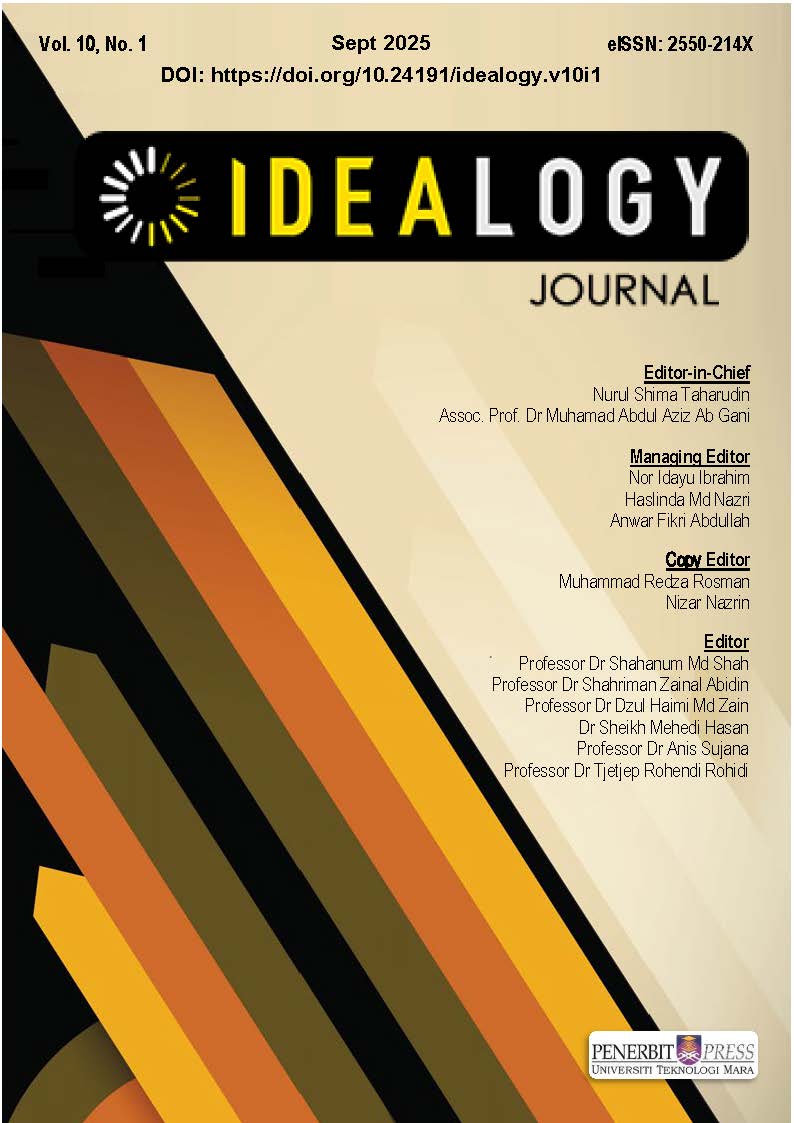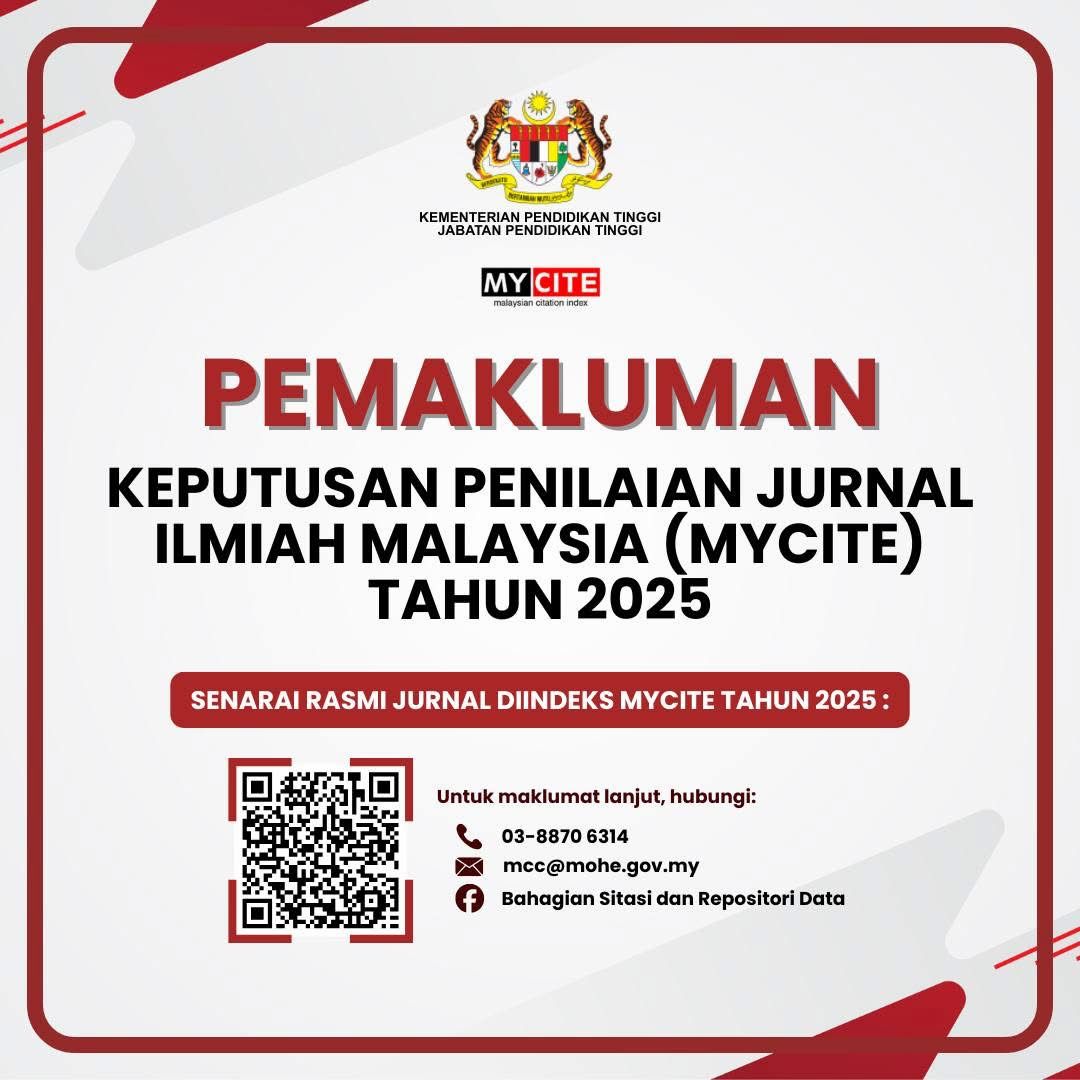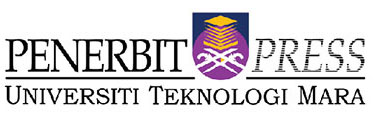Modeling Malaysian Visual Artists’ Readiness for The Artist Resale Right (ARR): A Conceptual Framework
DOI:
https://doi.org/10.24191/idealogy.v10i1.755Keywords:
Resale Royalty Right (RRR), Visual Artists, Intellectual Property, Creative IndustriesAbstract
The Artist Resale Right (ARR) aims to ensure that visual artists receive equitable compensation from the resale of their artworks in secondary markets. While widely implemented across more than 100 countries, Malaysia has yet to introduce a similar policy, leaving local artists excluded from the economic benefits of increasing artwork value over time. This article proposes a conceptual framework to model Malaysian visual artists’ readiness for ARR implementation, grounded in four established theories: Situation Awareness Theory, Social Capital Theory, Theory of Practice, and Institutional Theory. The framework identifies three key antecedents—experience with ARR, perception of ARR, and professional engagement—as predictors of artists’ comprehension and projection regarding ARR implementation. It also introduces institutional trust as a moderating factor. As one of the first scholarly attempts to structure ARR policy readiness in Malaysia, the framework offers theoretical depth and practical insights for researchers, policymakers, and cultural institutions. The study emphasizes the importance of artist-centered perspectives in shaping equitable intellectual property reform within the country’s creative economy.
Keywords: Artist Resale Right (ARR); Policy Readiness; Visual Artists; Conceptual Framework; Situation Awareness Theory; Social Capital Theory; Institutional Trust; Intellectual Property; Malaysia; Theory of Practice
References
Alonso-Borrego, C., & Romero-Medina, A. (2011). Wage expectations for higher education students in Spain (SSRN Working Paper No. 1836406). SSRN. https://doi.org/10.2139/ssrn.1836406
Altaf, A., & Masrek, M. N. (2021). Determinants and impact of work engagement: A conceptual framework. In EDULEARN21 Proceedings (pp. 10415-10426). IATED.
Angelini, F. (2017). Social capital in cultural markets: A systematic review. Journal of Cultural Economics, 41(2), 191–218.
Aksom, H. (2022). Organizational legitimacy revisited: Toward a new theoretical framework. Journal of Management & Organization, 28(5), 1177–1196.
Baron, R. M., & Kenny, D. A. (1986). The moderator–mediator variable distinction in social psychological research: Conceptual, strategic, and statistical considerations. Journal of Personality and Social Psychology, 51(6), 1173–1182. https://doi.org/10.1037/0022-3514.51.6.1173
Bille, T., Jensen, S. H., & Lauridsen, J. T. (2017). The working lives of artists in Denmark: Income, working hours, and job satisfaction. Journal of Cultural Economics, 41(3), 213–235.
Bourdieu, P. (1977). Outline of a theory of practice. Cambridge University Press.
Bourdieu, P. (1984). Distinction: A social critique of the judgement of taste. Harvard University Press.
Bourdieu, P. (1986). The forms of capital. In J. Richardson (Ed.), Handbook of theory and research for the sociology of education (pp. 241–258). Greenwood.
Capildeo, R., Haywood, C., & Yow, J. (2022). Copyright protection for painters, sculptors and cartoonists. In The subjects of literary and artistic copyright (pp. 78–97). Edward Elgar Publishing. https://doi.org/10.4337/9781800881761.00014
Coleman, J. S. (1988). Social capital in the creation of human capital. American Journal of Sociology, 94(Suppl.), S95–S120.
Dadswell, A., Wilson, C., & Bungay, H. (2024). Sustainable creative practice with older people: A collaborative approach between arts and care sectors. Sustainability, 16(3587). https://doi.org/10.3390/su16093587
Diyana, B. S. (2022). Cultural and creative industries and value creation: An analysis on Malaysian copyright laws. Malaysian Journal of Social Sciences and Humanities, 7(12), e001951. https://doi.org/10.47405/mjssh.v7i12.1951
Endsley, M. R. (1995). Toward a theory of situation awareness in dynamic systems. Human Factors, 37(1), 32–64. https://doi.org/10.1518/001872095779049543
Fillis, I., Lee, B., & Fraser, I. (2022). The role of institutional relationships in shaping the career development of emerging artists. Arts and the Market. https://doi.org/10.1108/aam-04-2022-0021
Holland, J., & Motlhaping, T. (2022). Artist resale right: Should Botswana codify? Journal of Intellectual Property and Information Technology Law, 2(1), 117–143. https://doi.org/10.52907/jipit.v2i1.207
Jewell, S. (2017). The artist’s resale right: International developments and challenges. WIPO Journal of Intellectual Property, 9(3), 213–225.
Kawashima, N. (2000). Beyond the division of attenders vs. non-attenders : a study into audience development in policy and practice.
Kregzdaite, R., Godlevska, E., & Vıdūnaıtė, M. (2022). Assessment Of Artists’socioeconomic And Working Conditions: The Empirical Case Of Lithuania. Journal of Empirical Economics and Social Sciences, 4(2), 61-78.
MacNeill, K., Lye, J., McQuilten, G., Badham, M., & Powell, C. (2022). The incomes of visual artists: Which artists, what income? Australian Economic Review, 55(4), 558–567. https://doi.org/10.1111/1467-8462.12495
Masrek, M. N., Harun, Q. N., & Zaini, M. K. (2017). Information security culture for Malaysian public organization: a conceptual framework. In Proceedings of INTCESS 2017 4th international conference on education and social sciences (pp. 156-166).
Masyhuri, M., Nadiyya, A., & Sylvana, G. B. (2023). The urgency of regulating resale royalty right on painting copyrights in Indonesia (Comparative study of Germany and Australia). Journal of Law and Legal Reform, 4(3), 365–398.
Maxwell, J. A. (2013). Qualitative research design: An interactive approach (3rd ed.). SAGE Publications.
Miles, M. B., Huberman, A. M., & Saldaña, J. (2014). Qualitative data analysis: A methods sourcebook (3rd ed.). SAGE Publications.
Nahmias, Y. (2019). The Cost of Coercion: Is There a Place for" Hard" Interventions in Copyright Law?. Nw. J. Tech. & Intell. Prop., 17, 155.
O'Dwyer, A. (2020). The artists’ resale right directive 2001/84/ec: A means of targeted intervention for visual artists. The Journal of World Intellectual Property, 24(1-2), 3–27. https://doi.org/10.1111/jwip.12170
Putland, C., Baum, F., & Ziersch, A. (2013). From causes to solutions—Insights from lay knowledge about health inequalities. BMC Public Health, 13, 219. https://doi.org/10.1186/1471-2458-13-219
Scott, W. R. (1995). Institutions and organizations. Sage Publications.
Sekaran, U., & Bougie, R. (2016). Research methods for business: A skill-building approach (7th ed.). Wiley.
Shaw Hong, S. E. R. (2020). Visual Arts Tourism in Malaysia: A literature review. International Journal of Culture and Art Studies, 4(2), 15-26.
Sherer, P. D., Rogovsky, N., & Wright, P. M. (2016). Legal environments, strategic choices, and firm performance: The case of labor unions in the United States. Academy of Management Journal, 43(3), 465–481.
Sovhyra, T., Ivashchenko, I., Strelchuk, V., Pyvovarova, K., & Tykhomyrov, A. (2023). The problem of introduction of digital technologies in the performing arts. ACM Journal on Computing and Cultural Heritage, 16(1), 1-8.
Szreter, S., & Woolcock, M. (2004). Health by association? Social capital, social theory, and the political economy of public health. International Journal of Epidemiology, 33(4), 650–667.
Tsounis, A., & Xanthopoulou, D. (2024). Social capital theory: A review. In S. Papagiannidis (Ed.), TheoryHub Book. https://open.ncl.ac.uk (ISBN: 9781739604400)
Wang, S. (2021). Resale royalty right for visual artists in the US and China: A comparative study. Frontiers of Society, Science and Technology, 3(1), 10–14.
Whetten, D. A. (1989). What constitutes a theoretical contribution? Academy of Management Review, 14(4), 490–495. https://doi.org/10.5465/amr.1989.4308371
Whitaker, A., & Kräussl, R. (2020). The art resale royalty: Impact on prices, liquidity and artistic creativity. Journal of Cultural Economics, 44(1), 1–29. https://doi.org/10.1007/s10824-020-09382-8
Yousaf, F., Masrek, M. N., & Bahry, F. D. S. (2023). Inter-Relationship of Cultural Intelligence, Emotional Intelligence, Knowledge Conversion Abilities, and Innovation Work Behavior: A conceptual framework. Environment-Behaviour Proceedings Journal, 8(SI12), 147-153.
Zeitoune, R. (2017). Droit de suite: A moral crisis. Binghamton University Undergraduate Journal, 3(1). https://doi.org/10.22191/buuj/3/1/9
Zitcer, A., & Teresa, B. F. (2024). Centering artist voices: notes from a survey of artists and cultural workers in Philadelphia, PA, and Richmond, VA. Urban geography, 45(8), 1504-1511.
Downloads
Published
Issue
Section
License
Copyright (c) 2025 Idealogy Journal

This work is licensed under a Creative Commons Attribution-NonCommercial-NoDerivatives 4.0 International License.
UiTM Press (the Publisher) has agreed to publish the undersigned author’s paper in Idealogy Journal. The agreement is contingent upon the fulfilment of a number of requirements listed below.
1. The undersigned author warrants that the paper entitled below is original, that it is not in any way libellous or unlawful in Malaysia, that it does not infringe any copyright or other proprietary right. The undersigned hereby represents and warrants that he/she is the author of the paper, except for material that is clearly identified as to its original source, with permission notices from the copyright owners where required. The undersigned represents that he/she has the power and authority to sign and execute this agreement.
2. The undersigned author warrants that the paper entitled below has not been published elsewhere, and also it will not be submitted anywhere else for publication prior to acceptance/rejection by this Journal.
3. By submitting the paper entitled below, the undersigned author agrees to transfer the rights to publish and distribute the paper in an international e-journal (entitled above) to Publisher.
4. The undersigned author agrees to make a reasonable effort to conform to Publisher's submission guidelines and to liaise with the editor to ensure that the requirements of these guidelines are met to a reasonable degree.
5. The corresponding author signs for and accepts responsibility for releasing this material on behalf of any and all coauthors. This agreement is to be signed by at least one of the authors who has obtained the assent of the co-author(s) where applicable. After submission of this agreement signed by the corresponding author, changes of authorship or in the order of the authors listed will not be accepted.




